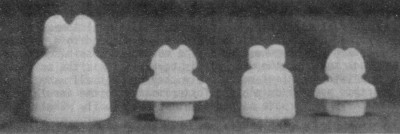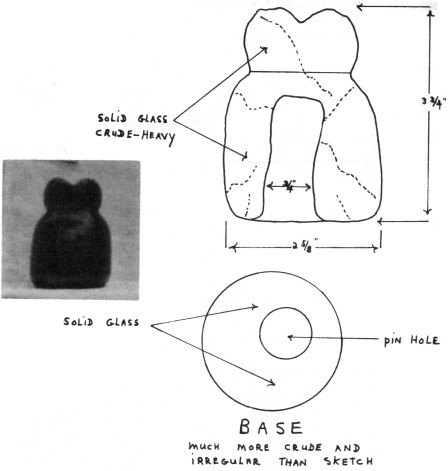Foreign Insulators
by Marilyn Albers
Reprinted from "INSULATORS - Crown Jewels of the Wire", July 1980, page 12
Insulators from Finland
This month we'll take a look at some
pretty insulators from Finland. I've never been there, but Frank Shiels (Fort
Worth, Texas) has, and in just a bit I will share with you a letter he wrote me
recently telling of his travels to this country. For still more about Frank, I
refer you back to the November 1979 issue of Crown Jewels, which covered his
year of study at the University of Madrid, his job on an off shore drilling rig
in Italy, etc. I have a feeling this young man will go far, and one day I will
be able to say I knew him "when".
But first a few facts about Finland.
It is an independent Republic in northern Europe and is a part of the
Scandinavian Peninsula. Finland borders Norway in the north, the Soviet Union on
the east, Sweden and the Gulf of Bothnia on the west, and the Gulf of Finland on
the south. Helsinki is the capital and the largest city.
It is a country of
swamps, lakes and forests. Finns call their country Suomi. The name Suomi comes
from a Finnish word meaning swamp.
Finland covers an area only a little smaller
than the combined areas of Minnesota and Mississippi, but it has about a million
fewer people. Finland has few natural resources, except timber and forests that
cover two thirds of the land. Most of the country's industry and trade is based
on forest products. The Finns have made the most of their resources. They have
built a modern industrial civilization with a high standard of living. They
often refer to their country as the "land of thousands of lakes".
About sixty thousand lakes dot the countryside. These lakes are joined by
streams and canals, and thus form waterways which lumbermen can use to float
timber to the mills and ports. Due to the fact that about eighty thousand
islands lie, along the country's rocky shores, making navigation difficult, many
boats travel on these inland waterways (about 3,000 miles of them) made up of
lakes, streams and canals. Most coastal shipping has to be carried on in the
summer, because Finland's harbors freeze over in the winter.
Finland has about
4,500 miles of railroads, mostly Government owned, and electric lights and
telephones in even the most remote regions. Much of Finland's power comes from
hydro-electric plants, relatively low heads of water making damming necessary;
but these have to be supplemented by thermal power stations. In 1958 engineers
began construction of a 130,000 kilowatt hydro-electric plant in northern
Finland where the Oulu River sites have been developed; and the Kemi River
system was harnessed in the 1960's. (Even rapids in many of the streams provide
hydro-electric power for industry.)
The white porcelain insulators pictured on
the following page are those that Frank Shiels brought back from Finland, and he
let me buy these from him. The general shapes are not a whole lot different from
those you might see almost anywhere in Europe, and for this reason I did not
include shadow drawings. The threaded pinholes are small (5/8" - 3/4")
and typically European. Three of the insulators have rather unique markings,
and, quite honestly, neither Frank nor I know their meanings. Maybe it's wishful
thinking, but perhaps the script F stands for Finland? Can you help? Anybody?

From left to right, figures 1, 2, 3 and 4.
I imagine these were made in
Finland, but I cannot be sure. One of the country's significant industries is
the manufacture of ceramics. In fact, Europe's largest porcelain factory is
located in Helsinki, while the cities of Riihimaki, Kahula, littala and
Nuutajarvi have international reputations for glass making. This is not to say
that these plants made insulators; but it is certainly very likely; and nowhere
could I find anything that said they didn't! Finland has an extensive need for
insulators because of its vast hydro-electrical system and its thousands of
miles of railroads. Remember, too, that almost without exception, every home has
a telephone and electric lights. The insulators in the picture are probably
telephone or low voltage power. They range in height from 3" to
4-1/2".
The green glass insulator pictured on the following page has got to
be one of a kind! It is so crude and thick and heavy that it looks like a
homemade jobby -- the whole insulator is solid glass, except for a threadless
pinhole that appears to have been made by inserting a rod of some kind up inside
the glass while it was still "plastic" and workable. That took care of
the pinhole. Next it looks as if someone just pressed another rather slender rod
down on top of the crown to fashion the conductor groove. There are no mold
lines, no markings, and no two sides of the insulator are the same. It is full
of stress cracks. I like to imagine that some clever Finnish farmer just went
out to his barn and whipped this up to replace a broken one somewhere on a line
running across his pasture, or, as Frank says, on the side of his barn! This is
the only glass one I have seen from Finland. Surely they weren't all made like
this one! At this point I am playing foster mother to the insulator, since Frank
seems to have a special attachment to it. Can't say as I blame him!

Large Image (76 Kb)
Following are excerpts from Frank's letter, dated 3-5-80.
Dear Mrs. Albers,
I
really enjoyed the article you wrote about E.S.A. insulators in Crown Jewels.
Someday soon I hope to sit down and write that story of my insulator findings in
Spain, but studying always seems to take priority. I am taking 19 (!) hours this
semester, I'm a resident assistant in one of the dorms, and am involved in a lot
of fraternity and extra curricular type things. I'm having fun and enjoying my
last semester here at Trinity. Next year I hope to be at SMU graduate school of
business ......................
Well, here is the story of my trip to
Scandinavia and the glass insulator: Only 10 Boy Scouts (Frank is an Eagle
Scout) from the Fort Worth and Arlington area were allowed to attend the 14th
World Boy Scout Jamboree in Norway -- held the 1st week of August, 1975. We joined
up with 20 boys from Dallas to form troop 32 and left the Dallas-Fort Worth
airport for Oslo, Norway. We toured the Oslo museums for a few days, then took a
bus to Lillehammer (120 kilometers north). It was here that we spent 7 action
packed days meeting, trading and camping with 17,000 Boy Scouts from 97
different countries. I traded my uniform for a Scottish one (complete with
kilt), exchanged patches, stories and addresses. After the Jamboree we stayed in
Stockholm for a week, then took the boat to Turku, Finland. From here a bus took
us to Rauma (a town along the western coast and north of Turku) where we met our
host families. It was the city where I found the green insulator. I had the
family show me an antique store and I tried to explain to them what I was
looking for. It's hard enough explaining to Americans what I collect and why;
you might as well give up explaining the hobby to Europeans. The store owner had
some Hemingray 42's, some porcelain insulators and one crude green glass one
that I thought to be threadless. It was definitely threadless, but the hole was
too narrow for an American pin. It was dark green with some stress cracks,
probably from the weather. The price in Finnish marks (markkaas) was the
equivalent to $10.00 in U.S. dollars. I asked the saleswoman if she spoke
English and she said "NO". Fortunately I had one of the family members
along and she could translate. The only information I got was that the insulator
was found by an elderly man, in the country, on the side of his barn. A few
months later the saleswoman sent me a letter saying she had 3 more insulators at
the same price. In my response I asked so many questions about what she had that
I think she gave up trying to have them translated. I certainly was not going to
pay $10.00 each if the insulators turned out to be Hemingray 42's.
Hope to hear
from you,
Sincerely,
Frank
- - - - - - - - - -
Before I sat down to write this I phoned Frank, and
he was able to fill me in a little more on the white porcelain insulators. The
husband and father of the host family he had stayed with in Rauma had a brother
who lived nearby. This brother had a farm, and Frank went there to see him -- not
looking for insulators. But he just happened to spot several of them lying in
sort of a trash heap in back of the barn. Some were still on the brackets. Frank
was invited to help himself, so he took one of each kind, and would have liked
more, but he knew there would be the problem of mailing them home.
Frank is to
get his Master's degree in Business at TCU starting next fall, instead of SMU as
originally planned. A summer job awaits him; but immediately after receiving his
Bachelor's degree in Business at Trinity College in San Antonio in May, he and
some fraternity brothers will head for a week of fun in Mexico!
Good luck to you,
Frank!
|
